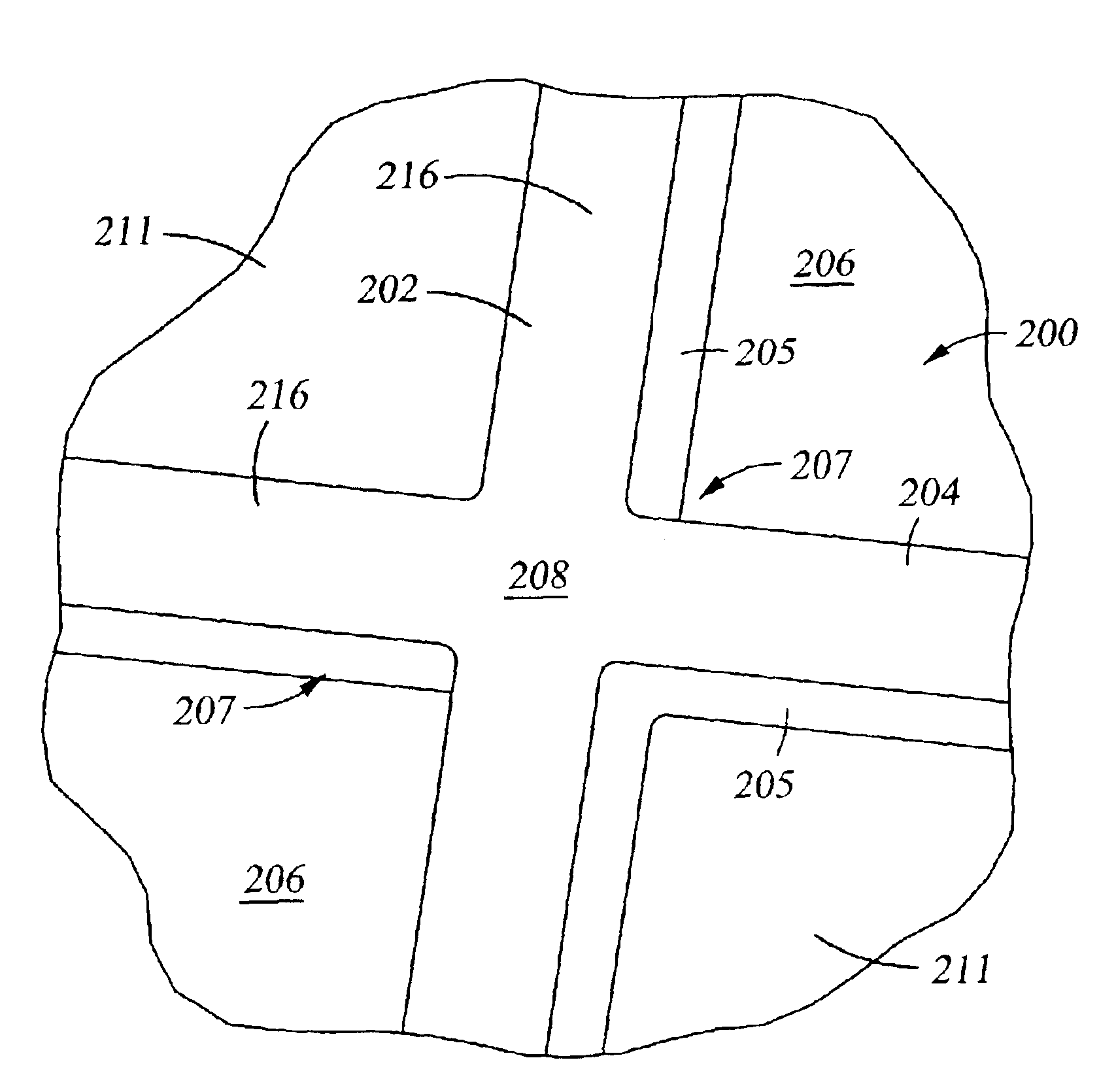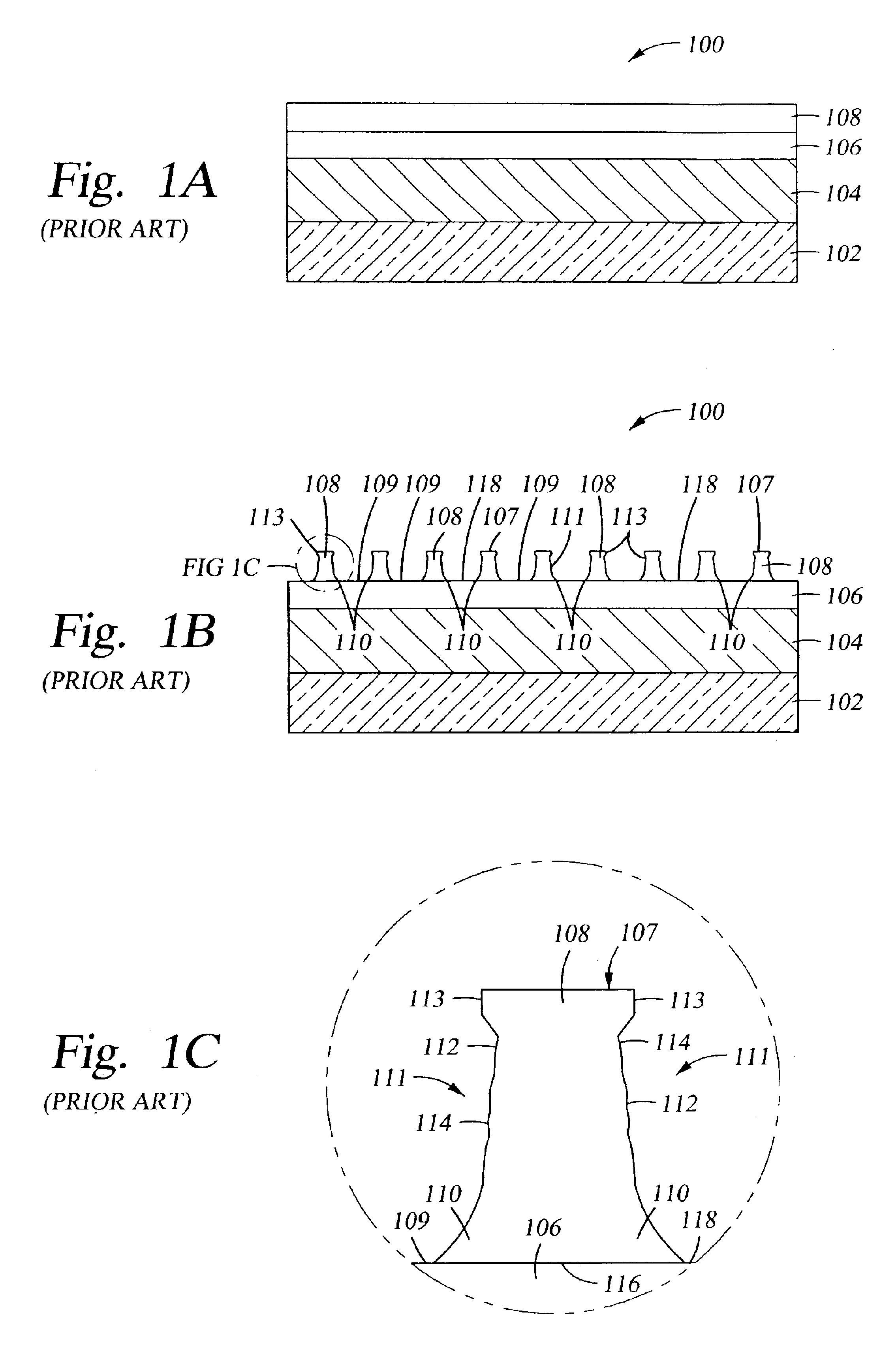Apparatus for reshaping a patterned organic photoresist surface
- Summary
- Abstract
- Description
- Claims
- Application Information
AI Technical Summary
Benefits of technology
Problems solved by technology
Method used
Image
Examples
example one
[0037]FIG. 1A shows a typical starting structure 100 used in the fabrication of a photomask, hereafter referred to as a reticle. In this Example, starting structure 110 was a stack of layers which included, from top to bottom, a 5,000 Å thick layer of a chemically amplified DUV photoresist, DX1100 (available from AZ Clariant Corp. of Somerville, N.J.); a 250 Å thick layer of an inorganic ARC, chrome oxynitride; a 750 Å thick layer of a mask material which is essentially chrome; and a silicon oxide-containing substrate.
[0038]In particular, the chemically amplified DUV photoresist comprises propylene glycol monomethyl; ether acetate; PMA; PGMEA; 1-methoxy-2-propyl acetate; modified phenolic polymer; and an onium salt metal halide complex as a chemical amplifier. The inorganic ARC was CrOxNy. The chrome-containing mask material was essentially chrome. The silicon oxide-containing substrate was quartz.
[0039]FIG. 1B shows a schematic cross-sectional view of the patterned photoresist laye...
example two
[0046]FIG. 3A shows a schematic of an isolated contact pad structure taken from a photomicrograph of a patterned photoresist layer 328, where the photoresist layer 328 was patterned in the manner described with reference to Example One, above. In this Example, the starting reticle structure was the same as described above; a stack of layers which included, from top to bottom, a 5,000 Å thick layer of DUV photoresist DX1100; a 250 Å thick layer of a CrOxNyARC; a 750 Å thick layer of chrome masking material; and a quartz substrate. The contact pad was essentially square, having a 0.75 μm length pad. Even after descumming, the presence of standing waves 324 on the surface 322 of sidewalls 327 was evident. In addition, a substantial foot 330 was present at the base of sidewalls 327 where photoresist 328 contacted ARC layer 326.
[0047]Again, we discovered it was possible to reshape the surface 322 of the patterned photoresist 328 to remove standing waves 324 and foot 330 by exposing the s...
example three
[0048]The range of process conditions useful in the reshaping of a patterned photoresist surface using an oxygen-comprising plasma are as follows, for a chemically amplified DUV photoresist comprising at least one ether acetate, and a modified phenolic polymer:
[0049]
TABLE IGeneral RangePreferred RangeMost PreferredProcess Variableof Variableof VariableRange of VariablePlasma Source10-20010-5015-19Gas Flow Rate(O2 sccm)*Process Chamber1-50 3-203-7Pressure (mTorr)RF Power to 1-500100-200120-130Cathode (W) at13.56 MHz**Substrate Bias10-750200-500350-400(- V)Substrate5-5010-3012-25Temperature(° C.)Process Chamber25-90 30-6035-50Temperature ° C.Processing Time15-24030-9050-70(sec)*An inert diluent gas such as a noble gas (He, Ar, Kr, Ne, Xe) may be used in combination with the O2, where the total gas flow remains the same as that specified. **It is contemplated that other power frequencies may be used.
[0050]One skilled in the art will recognize that the process conditions provided in Ta...
PUM
| Property | Measurement | Unit |
|---|---|---|
| Dimension | aaaaa | aaaaa |
| Antireflective | aaaaa | aaaaa |
Abstract
Description
Claims
Application Information
 Login to View More
Login to View More - R&D
- Intellectual Property
- Life Sciences
- Materials
- Tech Scout
- Unparalleled Data Quality
- Higher Quality Content
- 60% Fewer Hallucinations
Browse by: Latest US Patents, China's latest patents, Technical Efficacy Thesaurus, Application Domain, Technology Topic, Popular Technical Reports.
© 2025 PatSnap. All rights reserved.Legal|Privacy policy|Modern Slavery Act Transparency Statement|Sitemap|About US| Contact US: help@patsnap.com



